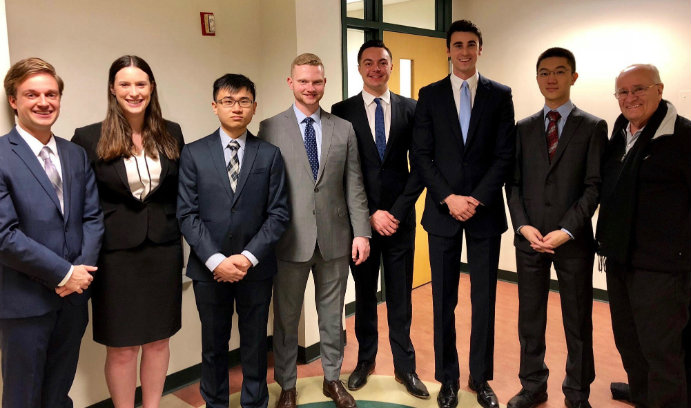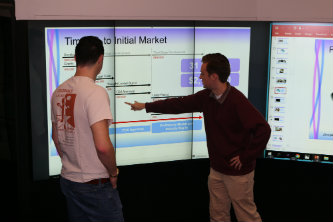Using Virtual Reality to Diagnose Glaucoma

John St. Pierre ’18 in the Center for Innovation in Teaching and Learning's new Visualization Lab. Photo: Jarret Brown
In what began as a quest to ease patient backlog and help underserved populations get screened for glaucoma, a team of seven students in Lehigh’s Integrated Business and Engineering (IBE) program has developed a prototype that utilizes virtual reality technology to administer a field test to screen for the crippling eye disease.
Students Alli Rubin ’18, David Morency ’18, John St. Pierre ’18, Winston La ’18, Zhuojie Ji ’18, Bryce Macomber ’18 and Sam Presti ’18 worked with ophthalmologist Dr. Avani Shah to develop the proposed Virtual Reality Visual Field Analyzer, which would need financing and FDA approval to bring to market.
Currently, about 3 million Americans have glaucoma, which damages the eye’s optic nerve and can lead to blindness. Because there are often no early symptoms, about half of the people with glaucoma don’t know they have it, according to the Centers for Disease Control. At higher risk are people over age 60, African-Americans over age 40, and those with diabetes or a family history of glaucoma.
The Lehigh team conducted extensive research and technical analyses of available virtual reality equipment as part of its year-long effort to determine market and need, in addition to creating the working prototype medical device that could yield the same results as stationary visual field analyzers currently used by ophthalmologists to help screen for vision damage.
The team’s prototype, which is portable and uses a virtual reality headset, includes a component that assesses a patient’s range of vision. The projected selling price is $5,000, as compared to the $30,000 cost of stationary visual field analyzers now used, the students said.
“There really is a big opportunity to innovate in this market,” said Rubin, as the team recently prepared for its hour-long presentation to students, faculty and staff as part of the IBE capstone course.
IBE, which is offered jointly by the College of Business and Economics and the P. C. Rossin College of Engineering and Applied Science, integrates courses in business and engineering with additional requirements in mathematics, science, English, humanities, and foreign language. The program results in a bachelor of science in integrated business and engineering degree.
In the program’s two-semester, six-credit capstone design course, teams of students work with faculty mentors on the marketing, financial and economic planning, and technical and economic feasibility of actual new product concepts. Pat Costa, professor of practice, is the primary instructor for the IBE Senior Capstone Design Program.
Lehigh’s Virtual Reality Labs
In developing its prototype, the IBE team working with Shah made extensive use of one of Lehigh’s virtual reality labs on the Asa Packer campus. Lehigh’s Center for Innovation in Teaching and Learning maintains two HTC Vive systems for virtual reality exploration by students and faculty. Its new Visualization Lab includes a MultiTaction Curved iWall to allow for collaborative investigations of digital information.
IBE team members spent considerable hours in the lab, using the HTC Vive’s open source hardware to create its software. Team members worked in phases, including being able to flash dots and record patient responses in the virtual visual field tests.
In general, visual field analyzers screen for damage to patients’ vision by testing patients’ range of sight—essentially, where they can and cannot see, the range of their side vision. The tests, one of three commonly used to assess patients’ risk for glaucoma, helps determine the damaged parts of patients’ eyes. The progression of the disease in patients also can be monitored.
St. Pierre said Shah, the team’s client, had a goal of making glaucoma tests more affordable and transportable, so that more people are able to be screened and have access to the care they might need. About 30 percent of the U.S. population don’t have easy access to ophthalmologists, team members said.
Another potential market for the product would be developing countries, where the need for glaucoma screening is even greater, they said.
“What this project aims to do,” said La, “is to provide a solution that is both accurate and portable, but at a low cost, using virtual reality.”
The team’s efforts were not limited to creating the software for the Virtual Reality Visual Field Analyzer. Team members also conducted extensive market research and financial analyses from January to December 2017, including start-up costs and distribution methods. They also conducted extensive research for securing patents, obtaining FDA approval, and selling the product, initially domestically.
The team placed the potential domestic market value at $240 million, if the product became widely used by ophthalmologists in well-served and under-served areas.
In the future, team members said, the product could be marketed for use in developing countries. Also, they said, the product could be further developed for other diagnostic testing.
Posted on:








